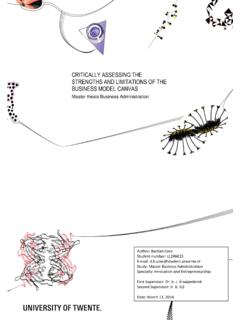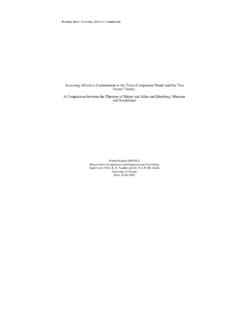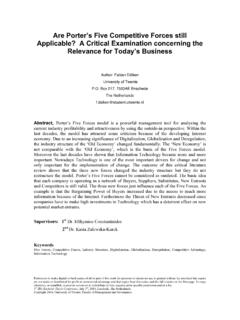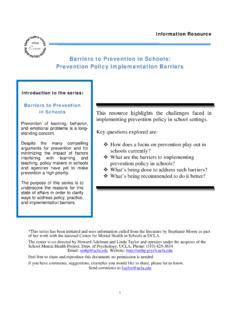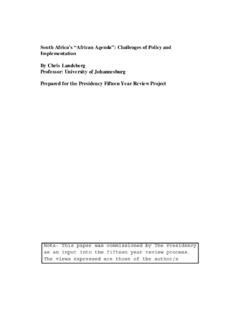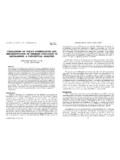Transcription of Strategy Implementation: Key Factors, Challenges and …
1 Strategy implementation : Key factors , Challenges and Solutions Author: Niclas Brinkschr der University of Twente Box 217, 7500AE Enschede The Netherlands ABSTRACT There is a difference between having a Strategy in mind and actually executing this Strategy . A lot of strategic considerations never make it into the real business operations. Effective Strategy implementation is the topic of this paper, therefore the paper is concerned with the composition of successful implementation and what needs to be considered. Despite is shows Challenges that can occur during the process and eventually how to solve them. Here literature from various other researchers gets connected to build a universal depiction of Strategy implementation and to give managers useful implications regardless of their industry. Additional to the theoretical part the paper also connects theory and practice through interviews with business people.
2 Supervisors: Dr. ir J. Kraaijenbrink Dr. K. (Kasia) Zalewska-Kurek Keywords Strategy implementation , Challenges , strategic consensus, resource allocation, leadership, vertical communication Permission to make digital or hard copies of all or part of this work for personal or classroom use is granted without fee provided that copies are not made or distributed for profit or commercial advantage and that copies bear this notice and the full citation on the first page. To copy otherwise, or republish, to post on servers or to redistribute to lists, requires prior specific permission and/or a fee. 4th IBA Bachelor Thesis Conference, November 6th, 2014, Enschede, The Netherlands. Copyright 2014, University of Twente, Faculty of Management and Governance. 1. INTRODUCTION The business context of organizations is an ever-changing environment. May it be a modified law, an innovative technology or a new behavior of people or customers, organizations find themselves often in a different setting and need to react accordingly.
3 The reaction can result in a change of Strategy . This strategic change is vital, because it helps to retain or gain competitive advantage in an altered business environment. Strategic change needs planning as a lot of issues arise and need to be solved. The feasibility and purpose are key to strategic planning, but also the organizational culture and structure will play a role in this stage. Strategic change and the successful implementation have one aim, a higher organizational performance. The biggest challenge in strategic change is however the phase after planning, the successful implementation of the Strategy that is needed and developed. This paper will deal with the issue of strategic implementation . As Olson, Slater and Hult (2005) say it, doing is harder than dreaming . Organizations invest a lot of time and resource in the planning of Strategy , but very little of it will get successfully implemented.
4 Research in this field will lead to a better understanding what can go wrong and why, but also what will foster success. Organizations that fail to develop its Strategy may fail on the long run. Today much is known about the important factors in the planning phase of Strategy . Furthermore problems, which appear during the implementation phase, are known. Some approaches and methods have been developed by researchers to ensure a structured processing; the most important factors of them will be introduced, summarized and connected during the paper. But a gap still exists between knowing what to do and actually doing it. Thus there is little systematic knowledge about how to implement a well-conceived Strategy on paper in the real day-to-day business of an organization. Without effective implementation even the most superior Strategy is useless as Aaltonen and Ikavalko (2002) realized.
5 The aim of this paper is to outline the Challenges and problems that can arise and hinder successful Strategy implementation , in connection with it the most important factors that foster it. But the most interesting part of the study will be the insights gained through the analysis of interviews from people in practice and their solutions to Challenges of Strategy implementation . The comparison of theory and practice might show unexpected differences. The research question is the following: How do organizations implement their Strategy ? Subquestions: What are the most relevant factors when implementing a Strategy ? What occurring Challenges can restrain Strategy implementation ? What are the solutions to overcome those Challenges ? 2. LITERATURE REVIEW This paper tries to find out how organizations can effectively implement their well- conceived Strategy . By effective implementation a superior performance and competitive advantage is meant.
6 Superior performance in comparison to the prior Strategy and competitive advantage that is hard to imitate and that gives the organization a time advance to its rivals in the market. It is necessary to find out the most important aspects in the implantation process to be effective and therewith successful. At first it is essential to illuminate the theoretical work done by many researchers in the topic of Strategy implementation like Guth, Nobel, Beer and many others on which this paper is grounded. The understanding for Strategy implementation grew over time through different researchers and diverse approaches. The literature review is an attempt to construct the most comprehensible connection between the different approaches and to involve the most important factors when implementing Strategy . The approaches developed try to cope with Challenges that exist in the organizational setting and may exist in the beginning of Strategy implementation or in its course.
7 Only organizations that will overcome these Challenges will be able to implement their Strategy effectively which shows their relevance for this paper. It will be interesting to compare theory of Strategy implementation and practical solutions and application in the course of the paper, integrating the insight of both to create a universal advise to implementers. As a point to start the paper will focus on the interplay between three variables, Strategy and organizational structure as well as the connection of both with behaviors of people. In the end the aim of strategic change is an improved organizational performance, and the interplay of Strategy , structure and behavior is key to understand how to reach a higher performance. Pryor, Anderson, Thoombs and Humphreys introduced a similar approach in 2007: The 5 P s Paradigm. The authors utilize the terms Purpose, Principles& Processes, People and Performance in their model.
8 Behind those terms all beginning with a P are Strategy (Purpose), structure (Principles& Processes) and Behavior (People). Despite they describe the connection between them as Strategy drives structure; structure drives behavior; and behavior drives results, in a top-down manner. The following figure shows the connections between the three different parts more intertwined and not top-down, as Strategy also has direct influence on Behavior and Behavior and Structure also have their influence on Strategy . The balanced interplay of all three leads to increased performance, which is the main objective of implementing a new or changed Strategy . Strategy Structure Behavior Figure 1: Strategy implementation setting From this basic figure it is easier to go deeper into the topic of Strategy implementation . People and their Behavior play an important role, as they are the ones who have to act according to the organizational Strategy .
9 The people act in specific organizational structures that affect their behavior, but also the behavior of the people has an influence on the organizational structure. All arrows depict the interrelation. Strategy is influenced by both and also influences them, as the Strategy shall be in accordance to structure and behavior of the organization to match it. As Pryor et al. (2007) put it, when implementing a Strategy , it s dangerous to ignore [..] components because Strategy implementation requires an integrative point of view , implying that managers and Strategy implementers have to keep in mind the interdependency of different factors and shouldn t neglect any. The following table shows the three key variables of this paper. The existing literature about Strategy implementation developed over years and researchers found factors that can be categorized into the three variables.
10 In the paper all these useful and important factors are compiled and ordered. The table shall serve as a visual support; each of the part of the table will be processed in more detail in the subsequent sections. Strategy Structure Behavior Formulation& Planning Cross-functional coordination Commitment of workforce Strategic Consensus Resource allocation Leadership of managers Control by management Cultural context Communication Strategy Strategy itself can be seen as a plan for an organization. After recognizing the need for strategic change, the manager sets goals. Then he must determine actions to achieve those goals with the resources he has available. Formulation and Planning Planning and Formulation of the Strategy are vital, according to Noble (1999). Prior to the implementation members of several functions should be involved in the Formulation stage. Those who get involved should have credibility, thus other stuff follow their lead and see the importance of change.

